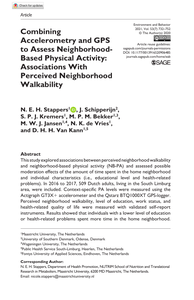This study explored associations between perceived neighborhood walkability and neighborhood-based physical activity (NB-PA) and assessed possible moderation effects of the amount of time spent in the home neighborhood and individual characteristics (i.e., educational level and health-related problems). In 2016 to 2017, 509 Dutch adults, living in the South Limburg area, were included. Context-specific PA levels were measured using the Actigraph GT3X+ accelerometer and the Qstarz BTQ1000XT GPS-logger. Perceived neighborhood walkability, level of education, work status, and health-related quality of life were measured with validated self-report instruments. Results showed that individuals with a lower level of education or health-related problems spent more time in the home neighborhood. The perceived neighborhood walkability only affected NB-PA for individuals spending a relatively large amount of time in their home neighborhood. PA-facilitating features in the home neighborhood, for example, aesthetics, were only associated with more NB-PA for individuals without health-related problems or with a higher level of education.
DOCUMENT

An increasing amount of cities are trying to increase civic engagement by using digital tools and platforms which gather data in a variety of ways on relevant topics within the city. Tools and platforms that focus on handling easy to fix issues on a local scale such as broken streetlights have been successfully implemented in cities already. In this paper a case study is described which aimed to retrieve data from citizens about a more complex local challenge in a neighborhood in Amsterdam. Furthermore, it has been investigated how the municipality could use the collected data as input for policy making. By making a participatory mapping mobile phone application available in a neighborhood, data was collected about places in the neighborhoods public space in which the citizens took pride and places that needed attention. This data is to be used as input for the area plan of the neighborhood. A first case-study with the application showed that even though there was low participation from the neighborhood, due to the high quality of the added data it was still valuable for the municipality.
DOCUMENT

In urban planning, 3D modeling and virtual reality (VR) provide new means for involving citizens in the planning process. For municipal government, it is essential to know how effective these means are, to justify investments. In this study, we present a case of using VR in a municipal process of civic participation concerning the redesign of a public park. The process included codesign activities and involved citizens in decision-making through a ballot, using 3D-rendered versions of competing designs. In codesign, 3D-modeling tools were instrumental in empowering citizens to negotiate design decisions, to discuss the quality of designs with experts, and to collectively take decisions. This paper demonstrates that, in a ballot on competing designs with 1302 citizens, VR headsets proved to be equally effective compared to other display technologies in informing citizens during decision making. The results of an additional, controlled experiment indicate that VR headsets provide higher engagement and more vivid memories than viewing the designs on non-immersive displays. By integrating research into a municipal process, we contribute evidence of cognitive and engagement effects of using 3D modeling and immersive VR technologies to empower citizens in participatory urban planning. The case described in the paper concerns a public park; a similar approach could be applied to the design of public installations including media architecture.
DOCUMENT

Residential electricity distribution grid capacityis based on the typical peak load of a house and the loadsimultaneity factor. Historically, these values have remainedpredictable, but this is expected to change due to increasingelectric heating using heat pumps and rooftop solar panelelectricity generation. It is currently unclear how this increasein electrification will impact household peak load and loadsimultaneity, and hence the required grid capacity of residentialelectricity distribution grids. To gain better insight, transformerand household load measurements were taken in an all-electricneighborhood over a period of three years. These measurementswere analyzed to determine how heat pumps and solar panelswill alter peak load and load simultaneity and hence gridcapacity design parameters. Moreover, the potential for smartgrids to reduce peak loads and load simultaneity, and hencereduce required grid capacities, was examined.